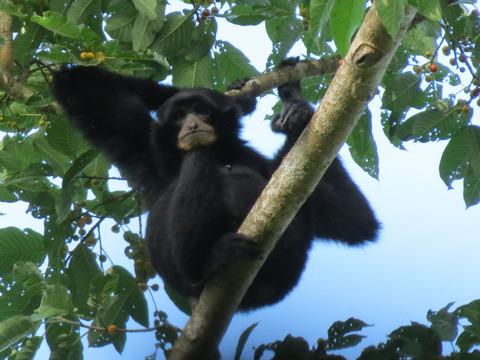当前位置:
X-MOL 学术
›
Anim. Conserv.
›
论文详情
Our official English website, www.x-mol.net, welcomes your
feedback! (Note: you will need to create a separate account there.)
Long-term effects of forest fire on habitat use by siamangs in Southern Sumatra
Animal Conservation ( IF 2.8 ) Pub Date : 2020-09-22 , DOI: 10.1111/acv.12640 S. Lappan 1 , M. Sibarani 2 , T. G. O’Brien 3 , A. Nurcahyo 4 , N. Andayani 2, 5 , E. L. Rustiati 6 , R. A. Surya 7 , L. Morino 8
Animal Conservation ( IF 2.8 ) Pub Date : 2020-09-22 , DOI: 10.1111/acv.12640 S. Lappan 1 , M. Sibarani 2 , T. G. O’Brien 3 , A. Nurcahyo 4 , N. Andayani 2, 5 , E. L. Rustiati 6 , R. A. Surya 7 , L. Morino 8
Affiliation

|
Forest fires can cause direct mortality to wildlife, and the associated habitat damage can reduce carrying capacity and population densities. However, little is known about long-term responses of animals to fire in the wet tropics. From 2000-2015, we examined siamang ranging patterns in habitat damaged by fire to assess the effects on these arboreal frugivores. We mapped home ranges (HR) of seven siamang groups inhabiting contiguous HR 3-5, 10-12, and 17–18 years post-fire. We predicted that if habitat connectivity or quality improved over time in burned areas, HR should become larger and centroid locations should shift toward recovering areas. Since territoriality constrains siamang ranging, we examined effects of social and habitat factors on ranging. By 18 years post-fire, tree density in the burned area had returned to the 1997 baseline, but composite LandSat images indicated that tree species composition differed in burned and unburned forest. Our data and the associated models indicated that HR sizes in burned forest increased over time whereas those in unburned forest did not. Centroid locations moved little (15.5 ± 6.9 m y−1) and their movement appeared to be predominantly influenced by social factors, although HR centroids in burned habitat shifted further into the burned area while those in adjacent unburned forest did not. In a large burned area unused by siamangs before 2012, two new groups were observed 15-17 years post-fire, although one subsequently disappeared. This is the first study of the long-term effects of fire on small ape habitat use. By 18 years post-fire, siamangs had incorporated some burned areas into their HR, but did not use heavily damaged areas. Reduced frugivore densities in burned areas may inhibit forest regeneration by disrupting seed dispersal.
中文翻译:

森林火灾对苏门答腊南部暹罗人栖息地利用的长期影响
森林火灾会直接导致野生动物死亡,相关的栖息地破坏会降低承载能力和人口密度。然而,关于动物在潮湿热带地区对火灾的长期反应知之甚少。从 2000 年到 2015 年,我们检查了被火灾破坏的栖息地的 siamang 测距模式,以评估对这些树栖食果动物的影响。我们绘制了火灾后 3-5、10-12 和 17-18 年居住在邻近 HR 的七个 siamang 群体的家庭范围 (HR)。我们预测,如果燃烧区域的栖息地连通性或质量随着时间的推移而改善,HR 应该变得更大,质心位置应该转向恢复区域。由于领土限制了siamang测距,我们检查了社会和栖息地因素对测距的影响。到火灾后 18 年,被烧毁地区的树木密度已恢复到 1997 年的基线,但合成的 LandSat 图像表明,燃烧和未燃烧森林的树种组成不同。我们的数据和相关模型表明,烧毁森林中的 HR 大小随着时间的推移而增加,而未烧毁森林中的 HR 大小则没有。质心位置几乎没有移动 (15.5 ± 6.9 m y-1 ) 并且它们的运动似乎主要受社会因素的影响,尽管燃烧栖息地中的 HR 质心进一步移动到燃烧区域,而相邻未燃烧森林中的 HR 质心则没有。在 2012 年之前 siamangs 未使用的大面积燃烧区域,在火灾后 15-17 年观察到了两个新的群体,尽管一个随后消失了。这是关于火对小猿栖息地利用的长期影响的第一项研究。火灾发生后 18 年,siamangs 已将一些烧毁区域纳入其 HR,但并未使用严重受损的区域。烧毁地区的食果动物密度降低可能会通过破坏种子传播来抑制森林再生。
更新日期:2020-09-22
中文翻译:

森林火灾对苏门答腊南部暹罗人栖息地利用的长期影响
森林火灾会直接导致野生动物死亡,相关的栖息地破坏会降低承载能力和人口密度。然而,关于动物在潮湿热带地区对火灾的长期反应知之甚少。从 2000 年到 2015 年,我们检查了被火灾破坏的栖息地的 siamang 测距模式,以评估对这些树栖食果动物的影响。我们绘制了火灾后 3-5、10-12 和 17-18 年居住在邻近 HR 的七个 siamang 群体的家庭范围 (HR)。我们预测,如果燃烧区域的栖息地连通性或质量随着时间的推移而改善,HR 应该变得更大,质心位置应该转向恢复区域。由于领土限制了siamang测距,我们检查了社会和栖息地因素对测距的影响。到火灾后 18 年,被烧毁地区的树木密度已恢复到 1997 年的基线,但合成的 LandSat 图像表明,燃烧和未燃烧森林的树种组成不同。我们的数据和相关模型表明,烧毁森林中的 HR 大小随着时间的推移而增加,而未烧毁森林中的 HR 大小则没有。质心位置几乎没有移动 (15.5 ± 6.9 m y-1 ) 并且它们的运动似乎主要受社会因素的影响,尽管燃烧栖息地中的 HR 质心进一步移动到燃烧区域,而相邻未燃烧森林中的 HR 质心则没有。在 2012 年之前 siamangs 未使用的大面积燃烧区域,在火灾后 15-17 年观察到了两个新的群体,尽管一个随后消失了。这是关于火对小猿栖息地利用的长期影响的第一项研究。火灾发生后 18 年,siamangs 已将一些烧毁区域纳入其 HR,但并未使用严重受损的区域。烧毁地区的食果动物密度降低可能会通过破坏种子传播来抑制森林再生。










































 京公网安备 11010802027423号
京公网安备 11010802027423号